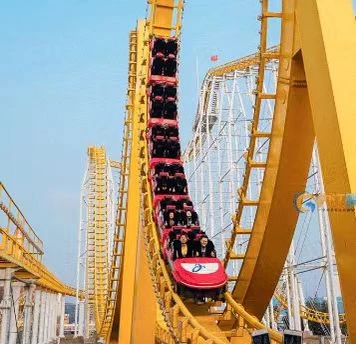- Albanian
- Arabic
- Belarusian
- Bengali
- Czech
- English
- French
- German
- Hebrew
- Hungarian
- Indonesian
- irish
- Italian
- Japanese
- kazakh
- Persian
- Russian
- Thai
- Uzbek
- Vietnamese
different types of roller coaster
Exploring Different Types of Roller Coasters
Roller coasters are one of the most thrilling attractions found in amusement parks all over the globe. With a rich history that dates back to the 17th century, roller coasters have evolved from simple wooden structures to complex, steel creations that defy gravity and provide adrenaline-pumping experiences. Within this evolution, various types of roller coasters have emerged, each offering a distinct ride experience. In this article, we will delve into the different types of roller coasters, exploring their characteristics, mechanics, and the unique thrills they provide to riders.
1. Wooden Roller Coasters
Wooden roller coasters are often considered the classic form of coaster design. Characterized by their construction from timber and their traditional aesthetic, these coasters provide a nostalgic experience reminiscent of the early days of amusement parks. They typically feature a series of steep drops, banked turns, and a rustic feel that many riders cherish. The wooden structure creates a unique rattle and creak that enthusiasts adore. Examples like the Cyclone at Coney Island and the Ghost Rider at Knott's Berry Farm showcase the enduring appeal of wooden coasters.
Steel roller coasters emerged in the 1970s and have since dominated the amusement park landscape. These coasters are renowned for their smooth rides and the ability to execute more complex maneuvers due to the strength and flexibility of steel. They come in various styles, including looping coasters, inverted coasters, and floorless coasters. Looping coasters, such as the iconic Corkscrew, feature upside-down loops that deliver a weightless sensation, while inverted coasters like the Batman ride suspend riders beneath the track for a thrilling experience. Steel coasters can reach astonishing speeds and heights, with some of the tallest and fastest in the world being made of steel.
3. Inverted Coasters
Inverted coasters are a subset of steel roller coasters that have the track positioned above the riders, leaving their feet dangling. This design creates a unique sense of flight, and riders experience a completely different perspective as they soar through loops and twists. Popular examples include the Montu at Busch Gardens and the Nemesis at Alton Towers. The sensation of hanging beneath the track enhances the thrill, making inverted coasters a favorite among adrenaline seekers.
different types of roller coaster

4. Launch Coasters
Unlike traditional coasters that are pulled up a hill before the drop, launch coasters utilize powerful propulsion systems to quickly accelerate riders from a standstill to high speeds. This design provides a unique thrill, often giving riders an immediate adrenaline rush. The Incredible Hulk Coaster at Universal’s Islands of Adventure is a prime example, launching riders at speeds of over 60 mph in mere seconds. Launch coasters can incorporate twists, loops, and airtime hills, keeping the experience exhilarating from start to finish.
5. Suspended Coasters
Suspended coasters, like the Big Bad Wolf at Busch Gardens, feature cars that hang below the track, allowing for a different type of maneuverability. As the coaster navigates turns and drops, the car swings from side to side, adding an extra layer of excitement. Riders experience a sense of freedom as they are gently swayed through the ride, setting suspended coasters apart from traditional designs.
6. Hybrid Coasters
In recent years, hybrid coasters have gained popularity, combining the classic structure of wooden roller coasters with the smoothness and innovation of steel. These coasters often feature wooden supports with steel tracks, allowing for high-speed and steep drops while maintaining the nostalgic feel of a wooden ride. The RMC (Rocky Mountain Construction) coasters like Steel Vengeance exemplify this trend, offering thrilling layouts and significant airtime.
Conclusion
The world of roller coasters is vast and varied, with each type bringing its unique set of thrills and excitement. From the classic charm of wooden coasters to the modern engineering marvels of steel and hybrid designs, roller coasters continue to captivate and thrill millions of riders each year. Whether you prefer the nostalgia of wood or the innovation of steel, the diverse offerings in amusement parks ensure that there's a roller coaster experience for everyone. As technology continues to advance, the future of roller coasters promises to be even more exhilarating, pushing the boundaries of thrill and creativity.
-
Flume Ride: Thrilling Water-Based Adventure | Hebei Zhipao Amusement Equipment Manufacturing Co., Ltd.Aug.01,2025
-
Flume Ride-Hebei Zhipao Amusement Equipment Manufacturing Co., Ltd.|Thrilling Water Attraction&NIST Safety StandardsAug.01,2025
-
Double Ferris Wheel Sale | Premium Custom RidesJul.31,2025
-
Flume Ride-Hebei Zhipao|Water-Based Attraction, Safety Standards, High-Speed DescentJul.31,2025
-
Flume Ride: Thrilling Water-Based Adventure & Advanced Engineering - Hebei ZhipaoJul.31,2025
-
Flume Ride-Hebei Zhipao Amusement Equipment Manufacturing Co., Ltd.|Thrilling Water Attraction&Customizable DesignJul.30,2025
